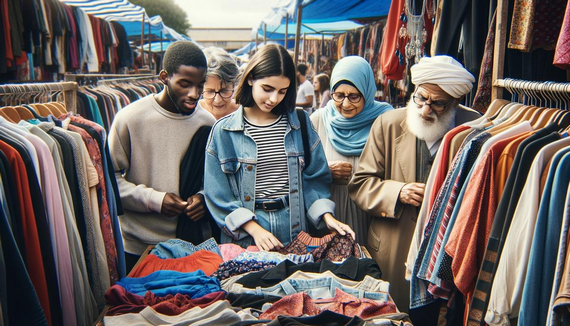What Are The Current Second Hand Clothes Trends
December 22, 2024Second hand clothes trends are gaining popularity as a sustainable alternative to fast fashion. The fashion industry’s environmental impact is significant, accounting for 10% of annual global carbon emissions and consuming excessive water. For instance, creating one pair of jeans can use up to 3,781 litres of water.
Second Hand Clothes Trends
Sustainability and Environmental Impact
Choosing used garments can significantly reduce this destructive cycle. A 2017 study showed that wearing second-hand clothes instead of purchasing new items reduces carbon emissions by nearly a third. Trends in second-hand clothes eco-conscious consumerism are making waves in fashion.
Platforms specializing in second-hand fashion are flourishing globally. Sites like Depop or ThredUP showcase inventories full of garments ready for a second life, blending style, nostalgia, and conscious consumerism.
The second-hand clothing market is projected to double by 2027, expected to be worth over $3.5 billion. Social media influencers and high-profile figures are showcasing thrifted finds, further popularizing the trend.
With only about 15% of clothing imports being recycled, most end up in landfills. In contrast, choosing pre-owned clothes promotes reuse instead. This shift in mindset balances our wardrobes and the planet, showing that what we wear matters as much as how we’re helping the world while doing it.

A bustling second-hand clothing market with diverse shoppers browsing through racks of vintage garments
Digital Revolution in Vintage Fashion
Technology has transformed the vintage fashion landscape for second hand clothes trends, making them more accessible and popular than ever before. Social media platforms like TikTok and retail apps such as Depop have democratized access to vintage fashion, turning it into a thriving cultural phenomenon.
TikTok drives this shift with users sharing thrift hauls, DIY upcycling tutorials, and trend inspiration. The platform allows diverse fashion influences from different eras to be showcased, helping vintage pieces find new admirers daily.
Apps like Depop have created virtual marketplaces where thrift treasures are easily accessible. Their social media-like layout creates an appealing shopping experience, attracting younger consumers who value individuality, sustainability, and unique finds.
Gen Z and Millennials are driving rapid growth in the second-hand market. By 2024, second-hand apparel is expected to make up 10% of the global apparel market, showing the growing importance of reimagined vintage fashion in the digital age.
The digital space also opens new avenues for storytelling. Each vintage item carries a story that connects with both seller and buyer, creating value beyond monetary worth. This personal connection reflects a shift where fashion is less about following trends and more about embracing styles that reflect personal and global histories.
Through modern tech, vintage fashion has become a vibrant mix of culture, influence, and expression that now belongs to everyone.

A young influencer creating a TikTok video showcasing vintage fashion finds in a trendy bedroom setting
Evolving Consumer Preferences
Second hand clothes trends among young shoppers, especially Gen Z and Millennials, are prioritizing uniqueness, affordability, and sustainability in their fashion choices. This shift is deeply rooted in their values, with data showing their strong preference for buying second-hand to express individuality and reduce environmental impact.
A recent study showed that many young people are influenced more by the quality and uniqueness of a vintage piece than by its brand name. This group is also more likely to buy pre-loved garments to stand out, avoiding the uniformity of fast-fashion and its unsustainable practices.
Second hand clothes trends in the vintage reselling market is thriving, with entrepreneurs tapping into this eco-conscious wave by curating collections that appeal to the diverse tastes of this young clientele. Thanks to platforms like Instagram and Depop, resellers can effectively reach a global audience.
Vintage pieces are often praised for their superior materials and skilled construction, qualities often lacking in fast-fashion. Investing in such clothing not only ensures a long-lasting wardrobe but also aligns with ethical consumption.
This cultural shift captures the essence of current fashion consumerism. Today’s buyers see fashion as a chance to vote with their wallets, supporting businesses that promote circular economies and encouraging sustainable practices across the industry.
Challenges and Market Dynamics in Second-Hand Clothes Trends
Despite its popularity, Second hand clothes trends in the second-hand clothes market faces challenges, particularly in profitability and quality control. Even well-known platforms like ThredUp and The RealReal have struggled to maintain consistent profits, with labor and logistics costs often exceeding sale revenues.
An oversupply of garments in the resale market is another issue. The constant influx of discarded items from fast fashion has created a surplus where the amount of available second-hand clothing exceeds demand, sometimes leading to prices higher than new, lower-quality fast fashion items.
Quality control is crucial. Sorting through large quantities of clothing to select wearable and desirable pieces is challenging. Inconsistent quality of incoming second-hand goods can disappoint consumers, especially when expectations are not met.
Solutions to Address Challenges:
- Investing in technology, such as scannable tags for inventory management, could reduce operational costs.
- Government policies could incentivize sustainable practices, fostering circular economies.
- Improved recycling infrastructure could help with oversupply by transforming unsellable items into raw materials for new products.
Consumer education can play a key role in helping shoppers understand the value and craftsmanship of upcycled and vintage clothing. Promoting quality over quantity may change expectations, encouraging purchases that are meaningful and long-lasting.
Addressing these challenges requires collaboration from businesses, consumers, and policymakers. By embracing innovation and recognizing the value of sustainable practices, second hand clothes trends in the second-hand fashion industry can continue to grow while maintaining its commitment to the planet and its people.
References:
- ThredUp. 2022 Resale Report. ThredUp; 2022.
- UN Environment Programme. Putting the brakes on fast fashion. UNEP; 2018.
- Ellen MacArthur Foundation. A new textiles economy: Redesigning fashion’s future. Ellen MacArthur Foundation; 2017.





